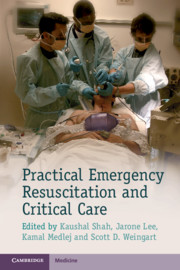Book contents
- Practical Emergency Resuscitation and Critical Care
- Practical Emergency Resuscitation and Critical Care
- Copyright page
- Contents
- Contributors
- Preface
- Abbreviations
- Section 1 General critical care
- Section 2 Trauma
- Section 3 Neurological emergencies
- 16 Ischemic strokes
- 17 Intracranial hemorrhage
- 18 Status epilepticus
- 19 Acute spinal cord compression
- Section 4 Cardiovascular emergencies
- Section 5 Respiratory emergencies
- Section 6 Gastrointestinal emergencies
- Section 7 Renal emergencies
- Section 8 Hematology–oncology emergencies
- Section 9 Infectious disease emergencies
- Section 10 Endocrine emergencies
- Section 11 Environmental emergencies
- Section 12 End of life
- Index
17 - Intracranial hemorrhage
from Section 3 - Neurological emergencies
Published online by Cambridge University Press: 05 November 2013
- Practical Emergency Resuscitation and Critical Care
- Practical Emergency Resuscitation and Critical Care
- Copyright page
- Contents
- Contributors
- Preface
- Abbreviations
- Section 1 General critical care
- Section 2 Trauma
- Section 3 Neurological emergencies
- 16 Ischemic strokes
- 17 Intracranial hemorrhage
- 18 Status epilepticus
- 19 Acute spinal cord compression
- Section 4 Cardiovascular emergencies
- Section 5 Respiratory emergencies
- Section 6 Gastrointestinal emergencies
- Section 7 Renal emergencies
- Section 8 Hematology–oncology emergencies
- Section 9 Infectious disease emergencies
- Section 10 Endocrine emergencies
- Section 11 Environmental emergencies
- Section 12 End of life
- Index
Summary
- Type
- Chapter
- Information
- Practical Emergency Resuscitation and Critical Care , pp. 123 - 129Publisher: Cambridge University PressPrint publication year: 2013

